Getting to know modern football and the modern desires that coaches have, we realize that all of the basic roles footballers have on the pitch change.
That being said, we witness the occurrence of rare-scoring strikers, no-assist midfielders and ball-playing centre-backs, which was clearly a paradox if said at any time in the 20th century.
Progressive managers have changed football in various ways, basing their play on the latter ones as the key to the attack openings.
Even though the creative central defenders are now hot goods, they needed to redevelop their style of play compared to the moment when this characteristic became a world-wanted brand.
That brought to light the tough guys who have what it takes to be included in build-up or even to be the main catalysts of actions from time to time.
Majestic players closely related to that role come from all around the globe, and Serbia has its successor of Nemanja Vidić in Nikola Milenković (as we said in an analysis in our last month’s magazine).
But, they have another big thing happening in the same position as they have Strahinja Pavlović being the embodiment of the tough ball-playing footballer spending his days in the centre of defence.
The youngster skyrocketed this season, making huge progress to what he’s been playing on the junior level and becoming a wanted guy for most of the big clubs in Europe’s five best leagues.
Monaco was the fastest one to grab him, getting him for a bargain price of ten plus three million in additional bonuses clause, pointing out that they are preparing turf for the time after Kamil Glik since he’ll come to their team after this season ends.
He’ll, if used wisely, become a good add-up to Leonardo Jardim’s successors’ tactics as the player loves to play the passing game, and the team is accustomed to playing it that way.
The ball in his feet is his best quality and he will surely be the first line of creation in Monte Carlo.
With all his flaws, it needs to be acknowledged that Pavlović is still 18 and has a lot to work on in future to become one of the greatest in the world, but his key abilities highlight that he has a glamorous potential.
What are the present and the future for the Serbian?
We’ll try to elucidate that through this tactical analysis scout report.
The “passing game”
Strahinja Pavlović made a huge leap in comparison to the first day he stepped on the pitch in Partizan’s senior squad.
The one thing he brought with him from the junior sides and perfected it by playing on the highest level is his in-possession play.
His passing skillset was, and still is, an important addition for the Belgrade Black and Whites and Savo Milošević nurtured the quality his player had brought into a very impressive point.
His numbers are quite good in the attacking and passing columns and he is the attack starter for his side on multiple occasions.
The centre-back’s inclusion in play is tremendous and he is engaged whenever his team is in possessional attack shape.
That’s probably the one thing Monaco counts on in future, making the youngster lead the build-ups in the passing-oriented side of that team.

This season perfected Pavlović’s percents, his passes are exquisitely accurate as we can see above.
The most important thing about the passing accuracy rate is that he loves and tends to play it forward, so the number isn’t boosted with a bunch of side passes.
He plays 28 balls towards the opponent’s goal per 90 minutes, with a high percentage of 77,4, along with 11 passes to the final third per game which is notably high for a defender.
His involvement in the actions is mostly reflected through his line-breaking balls.
The youngster has developed good communication with his forward players and tries to supply them with passes that will splinter the opposition’s defensive structure.
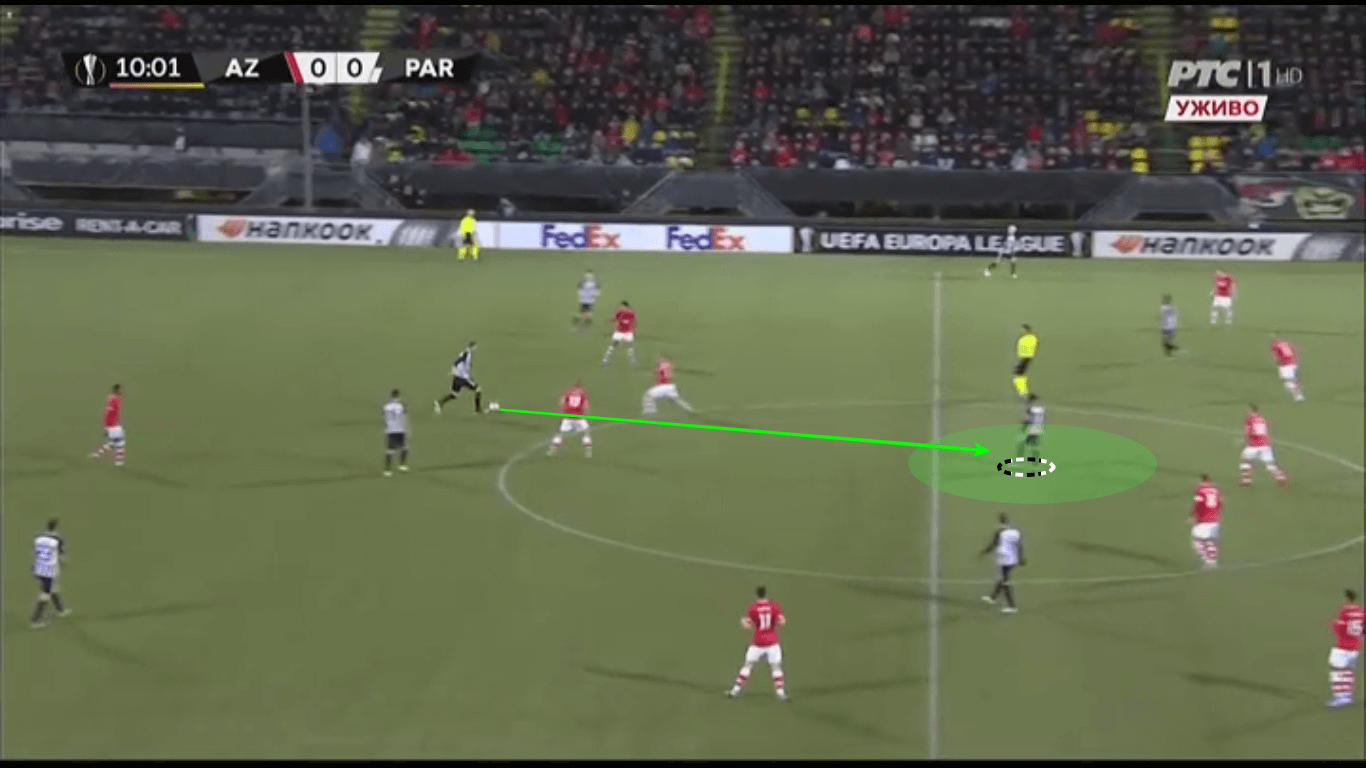
He is sure on the ball and thrives under pressure, making it easier for his team to play through the ground and get out of the tough situations.
Pavlović time and again finds the between-the-lines positioned players which allows Partizan progress.
Aleksandr Golovin, Cesc Fàbregas and Wissam Ben Yedder are the best examples of players that will bond with the centre-back and help him establish the pass-gap connection in Monaco.
As much as he plays those passes under pressure, he does it with ease against the formed blocks in which sometimes rivals sit.
He feels comfortable with the ball in his feet and tries to play passes that force his teammates to go in the free space.
Although they are indeed the through passes, they are seen as the regular ones because of their length and speed, so they are not listed as the through ones in his stats.
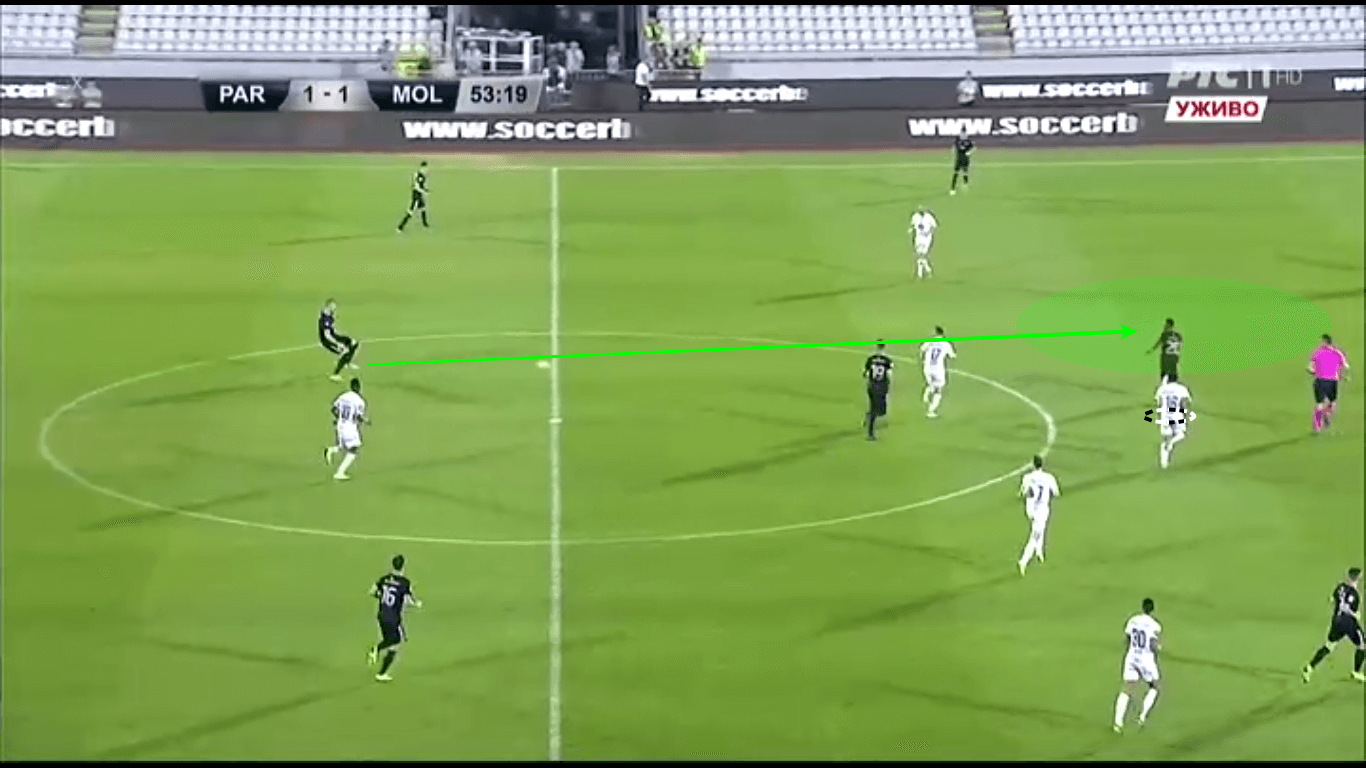
Here we can see the example of one of those scenarios when the player calls his midfielder to go for the ball aiming it between the opposition’s lines right to the open room.
Those passes vary in terms of distance and are mostly sent through the ground, but the player himself often wants to skip the action and send long balls towards the flanks where the main targets are fast players up top (in Partizan there are Umar Sadiq and Takuma Asano, in Monaco those will probably be Gelson Martins, Keita Baldé and Henry Onyekuru).
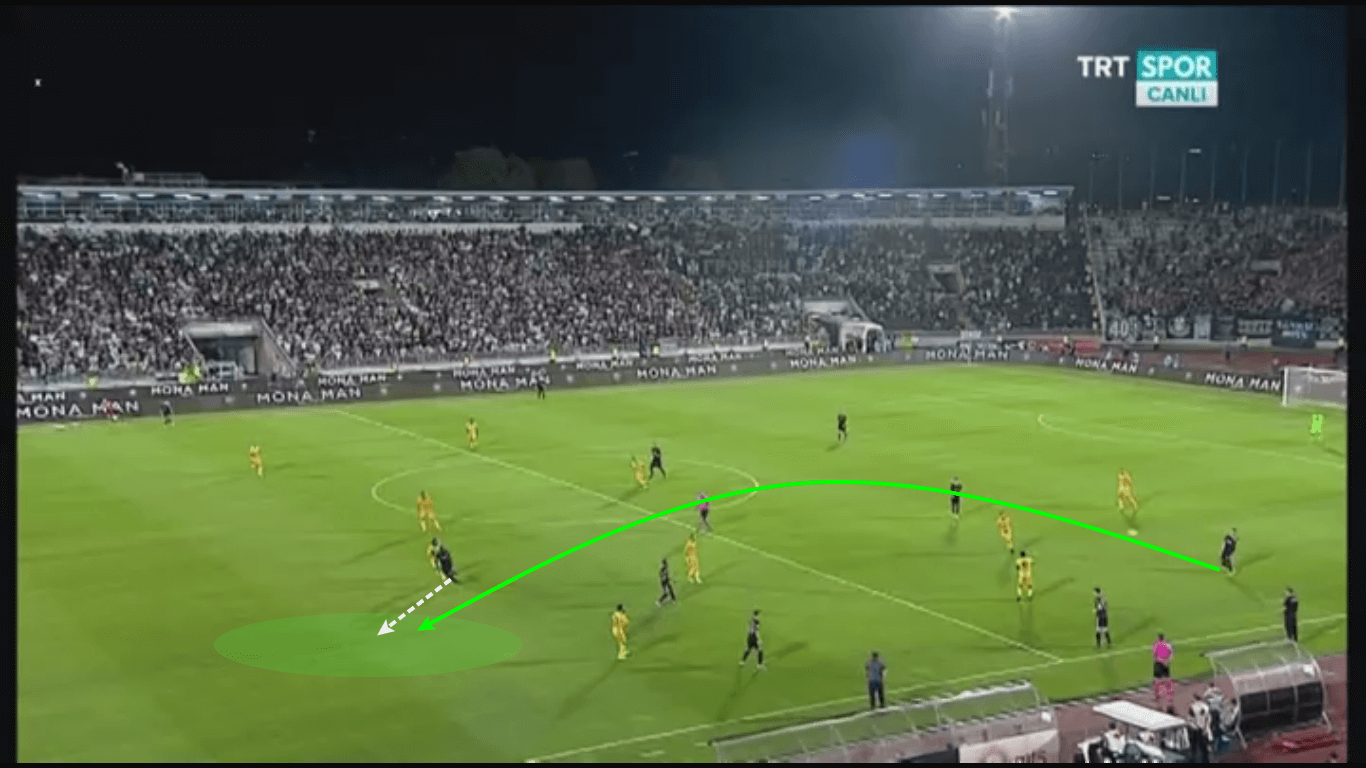
In the picture, we can see the pattern of these actions that mostly happen when the youngster gets closer to the left-hand sideline and against the central blocks of the opponent.
That creates enough gap for the forwards to run into and allows him to precisely skip the formed defensive structure.
Also, Pavlović is keen to win the space with the ball in his feet dribbling into the free space if the one opens up.
He doesn’t run away from the in-possession responsibility and drives forward whenever there is room for those underlaps.
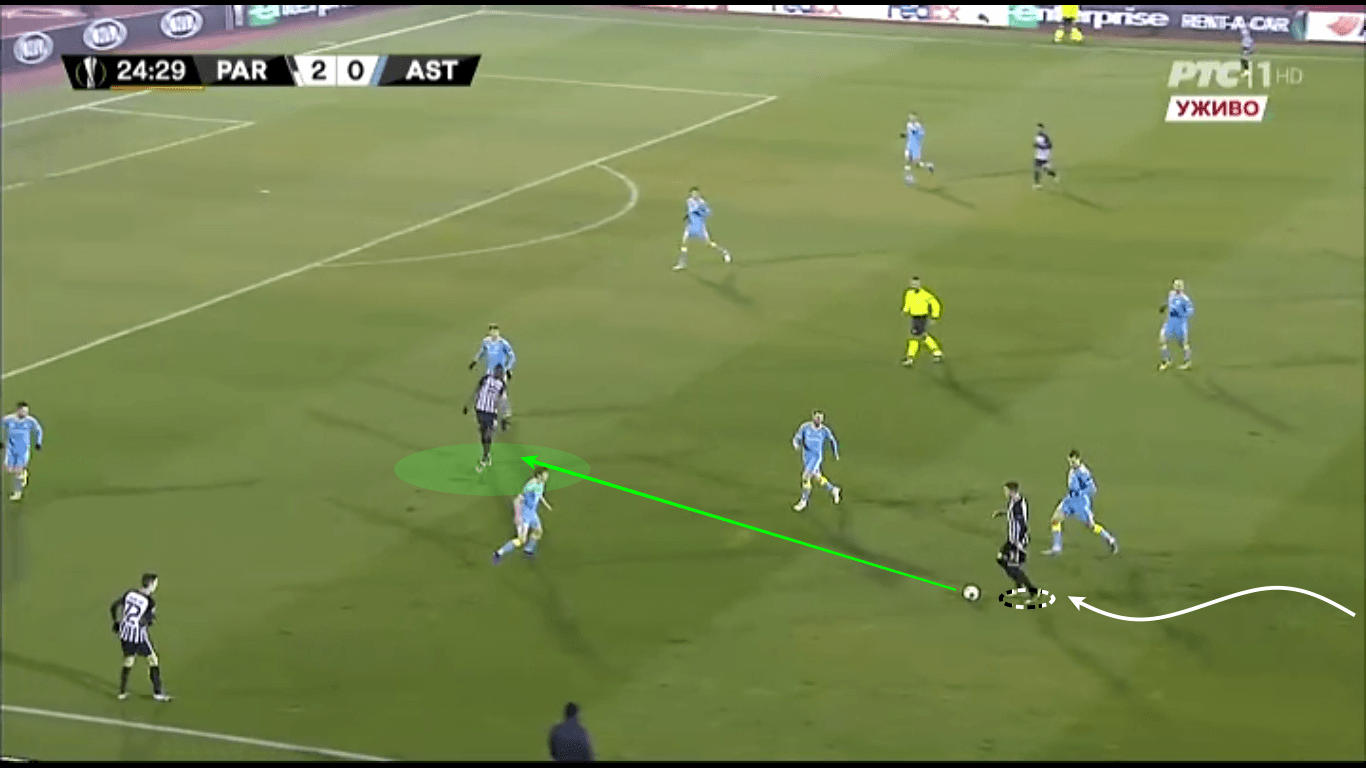
When the opposition cuts down his progress and surrounds him, he doesn’t panic and tends to play it through them to the players mainly positioned in half-spaces.
That is an addition to the build-up in the lower zones of the pitch as it mostly depends on his good communication with well-positioned midfielders and attackers, which we pointed out earlier.
Pros and cons of defensive positioning
In terms of motion, the young defender is quite mobile and present around the pitch.
He mostly operates in the left inner corridor and has the freedom to go forward if space opens up for it, as we said before.
That makes him included in various events in the game, and because of the type of football his team plays, he’s often caught up sitting very far from his own goal.
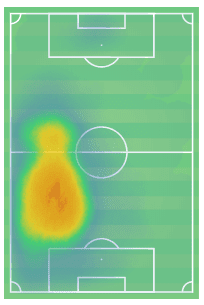
We can see in his heat map his most favourable area of the field and where he spends his days mostly.
It is very significant to say that he, as it is shown, finds himself frequently on the opposition’s half playing somehow in the midfield zone, and doing that basically as much as he does find himself at the edge of his box.
He is really good at covering depth in the low stages of the pitch, where his communication with teammates brings him to position himself wisely.
Pavlović is a good box controller and has a good vision of how to defend against crosses and flank dangers due to his nice sense of action.
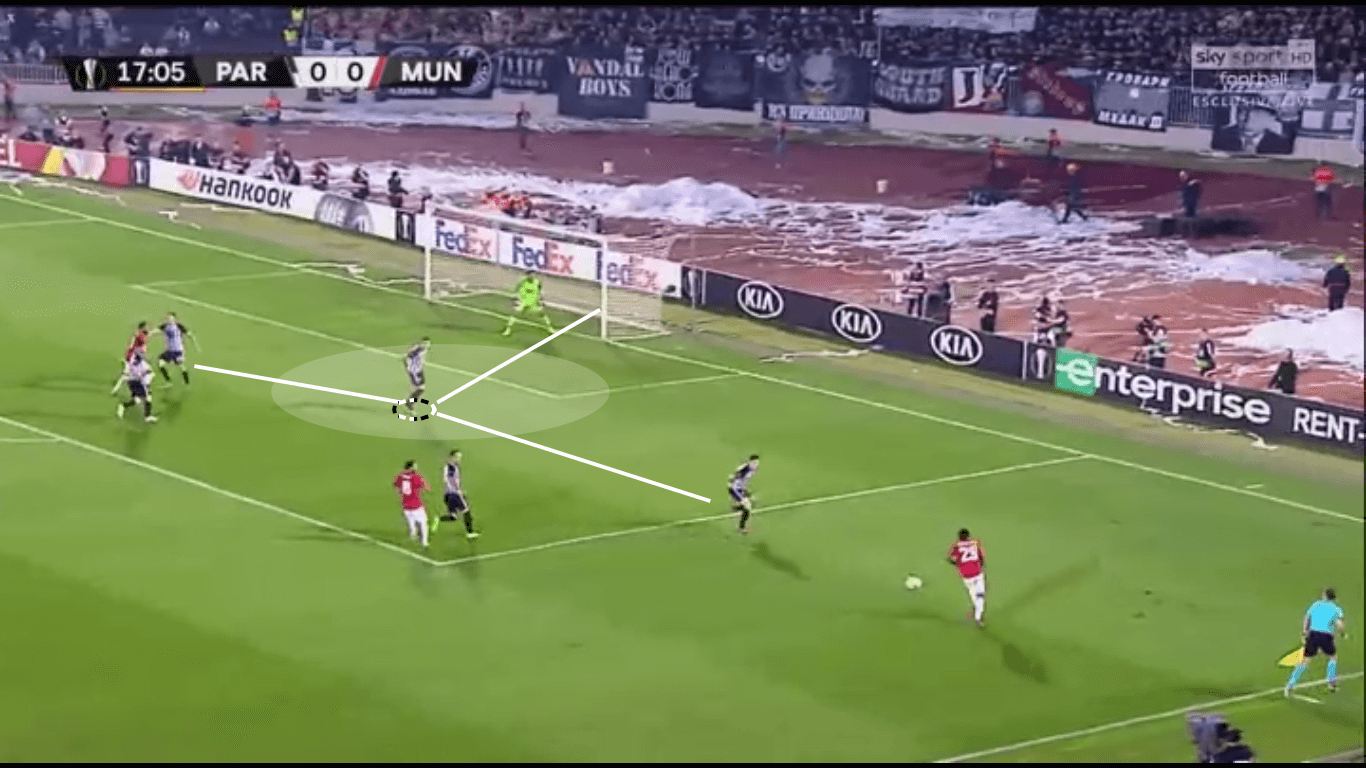
Here we can see how well-positioned he is in terms of distance-keeping between himself, goal, teammate behind him and the one guarding the player with the ball.
He doesn’t complicate too much if the ball is heading towards him in those scenarios, repeating clearances because of good body positioning.
That isn’t always the case with him as he oftentimes fails to position his body in the right way so the direct opponents have an initial advantage over him.
Positioning while in negative transition and against the long balls are the two segments he needs to work on and the ones with which he currently struggles.
He manages to cope with them with his strength, long pace and aggressiveness but still has a lot of room to upgrade his skillset.
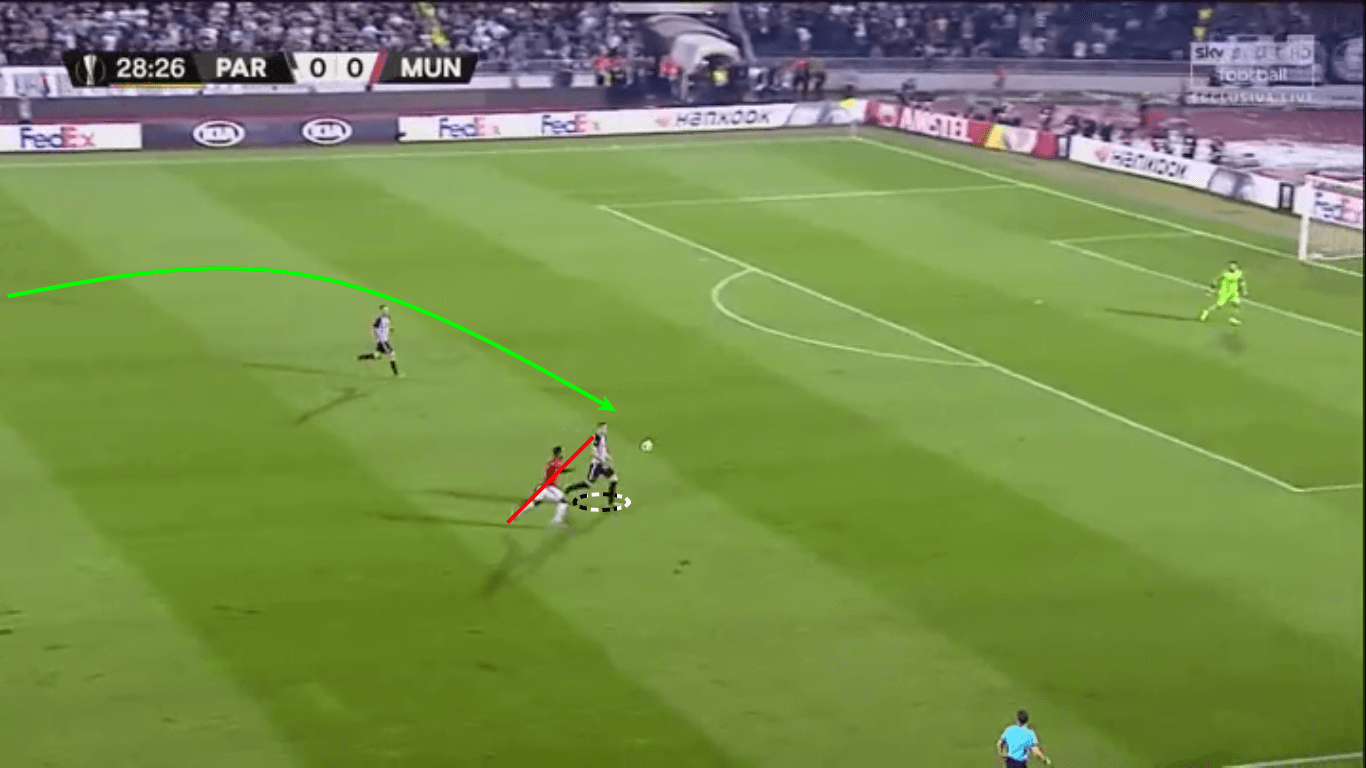
For example, a lot of passes similar to the one shown above can make him go into trouble because of his occasional (too) high positioning.
We see that he got the better of Anthony Martial because of his physical qualities, but initially, the attacker had the availability to move faster forward.
The player compensates for the issues of positioning with his excellent duel game and with the long legs that save him time in plenty of situations.
Also, his aggressiveness helps him come out of the bad positioning and makes him win the ball even when he isn’t in the best shape to do so at first.
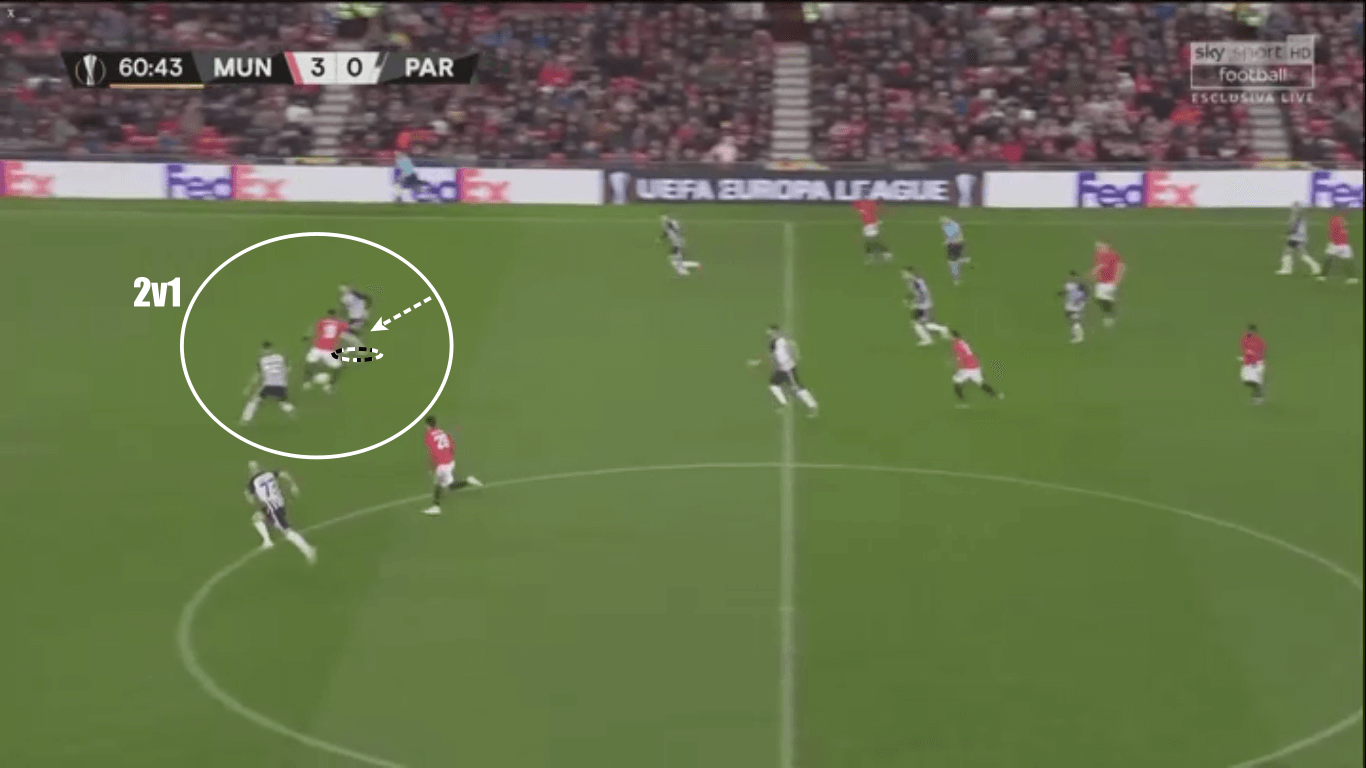
On the pitch positioning and bad body-positioning occur together sometimes, and he copes with them with the said set of skills.
In the picture, he hasn’t set his body well enough and he gave the opponent the chance to get the ball, but due to his aggressiveness succeeds in finding his way back and helping his teammate create a surplus over the player in possession.
Anticipation and support
Although he has his flaws in the defensive game, he also has his qualities, as we pointed out in the last chapter.
One of his many good characteristics when it comes to out-of-possession play is anticipation which helps him provide his teammates with support in many different phases of the game.
Due to his strength, his presence in the duels is very lucrative for his team so he doesn’t run away from going higher to help win the ball back if he senses so.
Those situations mostly happen when the player receiving the ball is faced towards his own goal and Pavlović tends to come from the back with a huge amount of aggressiveness anticipating the pass before it actually happened.
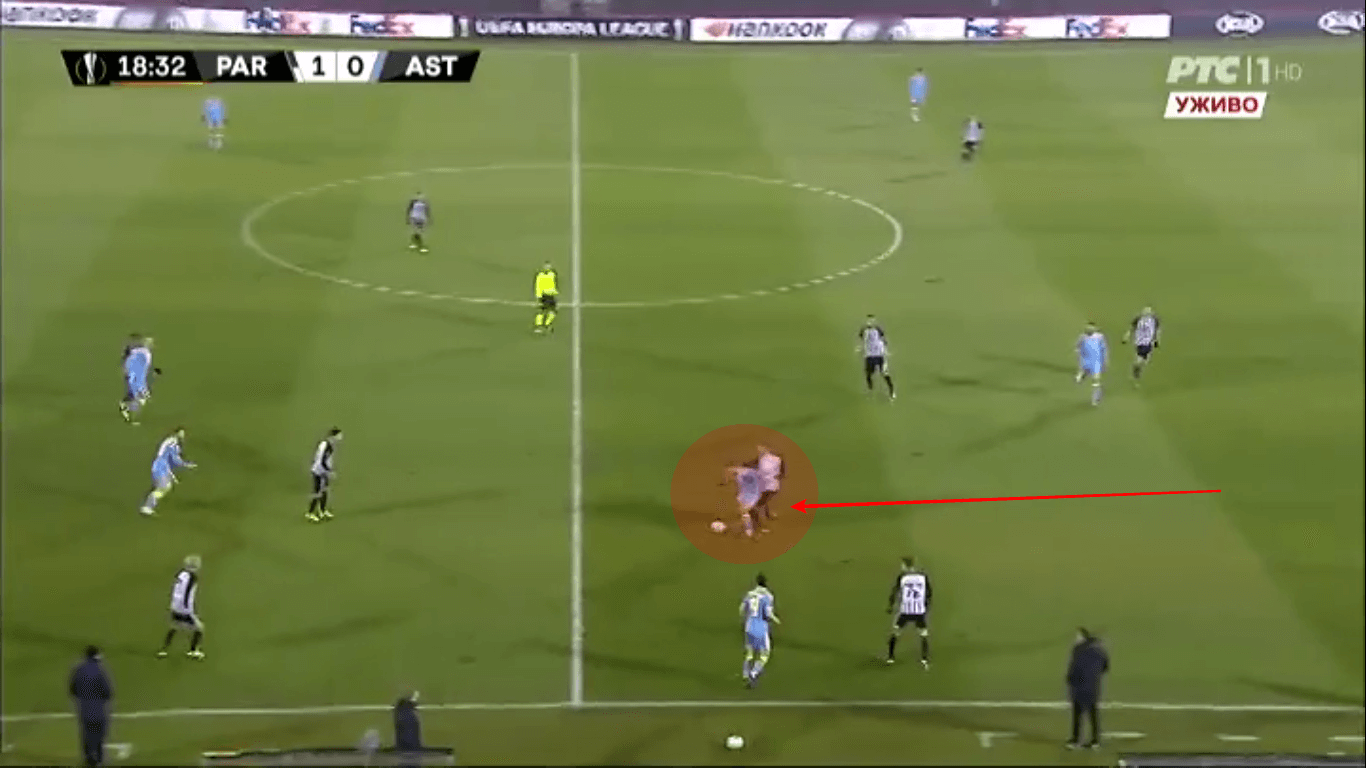
The youngster repeats those runs habitually and regains possession for his side because of his strength and aggressiveness added up to the anticipation.
He uses that segment of his game to provide higher teammates with support and to not let the opposition enter the final third of the attacking side of the pitch.
Those motions allow his team to have surplus settings against opponents right before they come into the threatening positions, and then his side could counter with a starting numerical superiority in the restricted area.
That will be quite helpful to Monaco’s midfielders, especially Fàbregas and Tiémoué Bakayoko who both often need help from behind to win the clear ball.
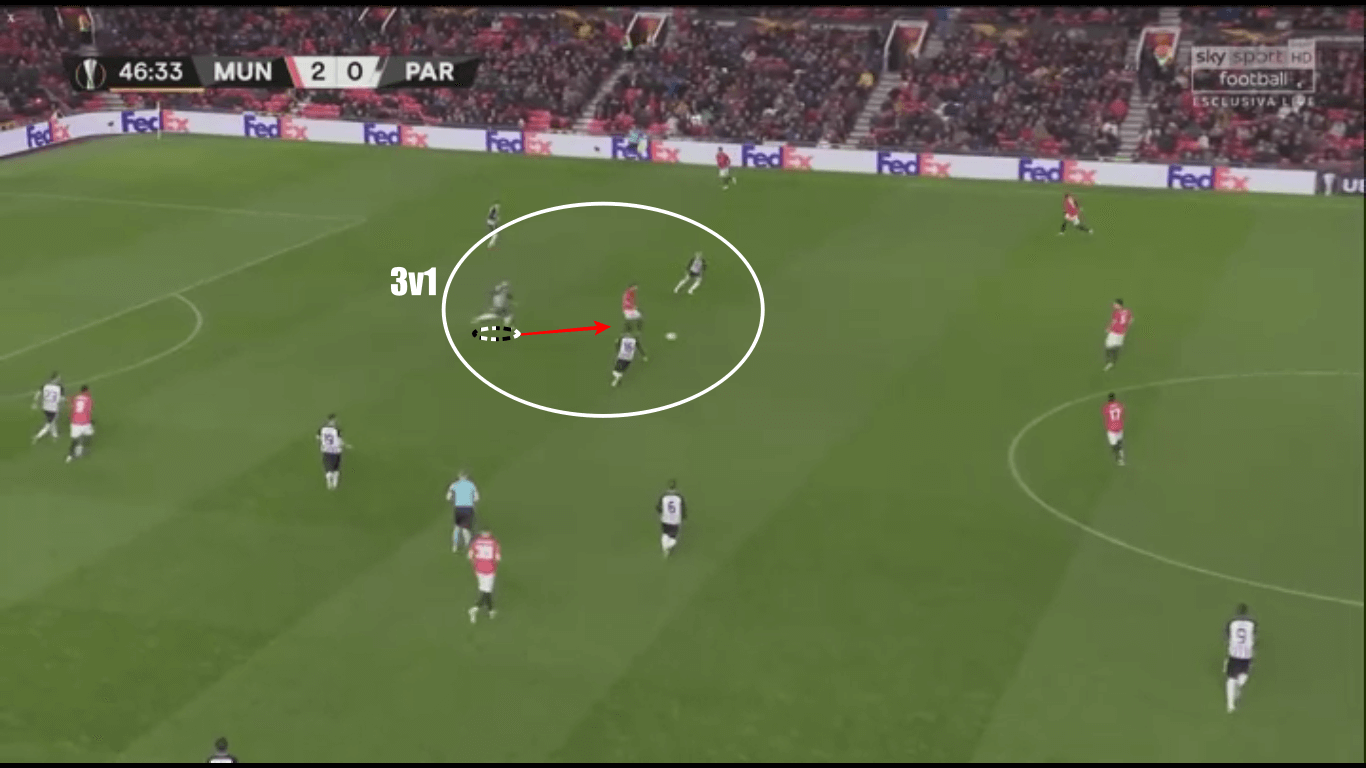
As we can see, Pavlović helps his higher players form the “3v1” situation over the man with the ball and that leads them to get in possession.
From there on, they can move forward progressively and could play against the unorganized defence, which can be very profitable for his future team because of the pacey attacking arsenal they have.
His numbers are also brilliant when it comes to the general defending, spotlighting the fact that he’s a tough guy but at the same time a bit of classy one.

The youngster wins 77,3% of his defensive duels which is quite good for his age and experience.
The most important talking point in these stats is the fact that he makes just 1.21 fouls per game and goes for a slide just once in three games – meaning that he tends to be closer to the action and within the limits of rules.
Also, the parameter of the need to progress is the number of lost balls, as he allows 9.53 turnovers per 90 minutes, making almost four of them at his own half.
Altogether, his defence is good but needs to be improved if he wants to get to the heights of Vidić and also Milenković, who became Serbia’s best defender and will surely be Pavlović’s pair in the national team’s defensive line.
Monaco’s potential setup
The thing about Monaco is that isn’t clear what is going to happen next summer when the young defender completes his transfer in their ranks and what will they look like in terms of the coaching staff and men’s roster.
Appointing Pavlović is the indicator that they will stick to a possession-based football, as his best characteristics are passing skills and the idea of forwarding play.
The two biggest questions are who will accompany him in the centre of defence and in what formation Monaco will play in.
If we pick up the most common shapes Jardim and his predecessors used in the past, it is clear that is most probable that they will line up with the three at the back for the majority of games (most probably in the 3-5-2 tactics).
If so, there are two solutions for the coach to get the best out of the 18-year-old.
In the first one, he’d be playing as the left centre-back with the freedom to join attacks and participate in the build-up, as he often does in Partizan.
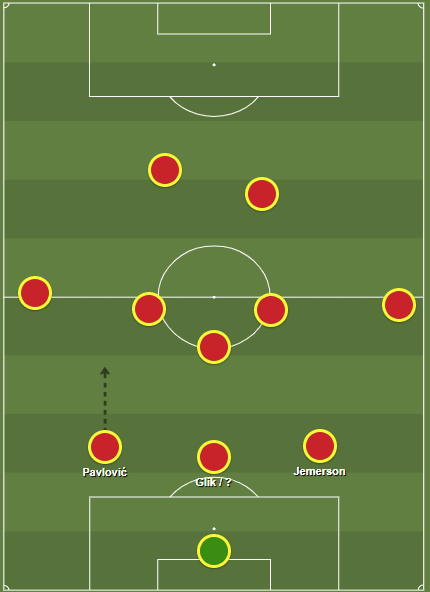
As we said before, he has a tendency to push forward if space opens up for him to do so, and from this position, he’ll have the liberty to repeat those runs.
Also, playing him as the left centre-back in the back three, takes some defensive responsibility of his back, providing him with support and neutralizing his positioning flaws with the numerosity of players.
That would probably be the best option for them at the start, but he’ll need to embrace the idea of defending in the future so it will be better for his development to get bigger obligatoriness.
It is not clear who he’ll be playing with – Jemerson is the most possible player in the same role on the opposite side, while time will tell about the third player which can easily be Glik (that would affect the speed of the defence).
The second solution is to play Pavlović as the central player in the three-man defence, where he will play as a conductor, being the one playing the opening pass in the attacks.
From there he’d have a bigger defensive responsibility and would be controlling the line in the block, and shaping the forward players as the organiser.
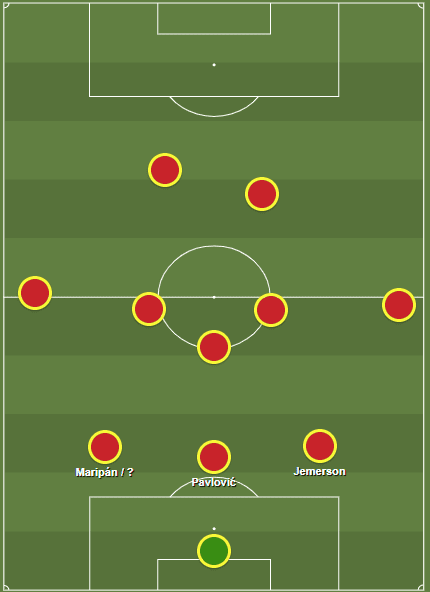
Here, as everywhere, repeats the not knowing who his coworkers will be, but Serbian will get the room to make errors and learn from them in the position which could make him fulfil his potential.
The third option is tightly related to the changing of the system because it will probably be the four-men defence as the “plan C”.
In that tactic, Pavlović will play his well-known role which he fills week in week out in Belgrade with the other player being the position-responsible one and he’d be the one joining attacks.
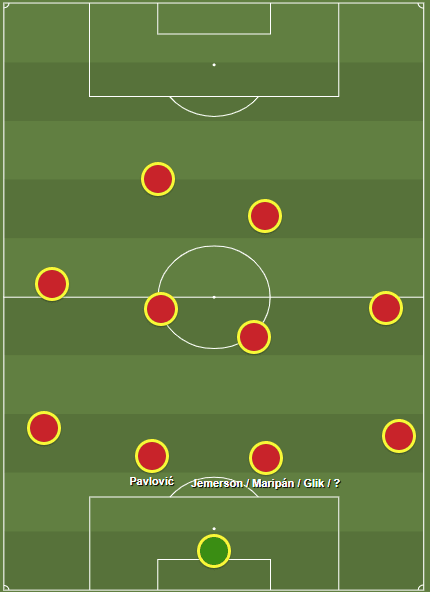
Once again, it all depends on the guys playing along with him, and if he gets the proper supportive staff, he’ll easily explode into one of the hottest goods in the future market.
The mixture of the three throughout the season will probably have the best impact on the player as he’ll get the chance to find himself in a variety of positions in which he’ll be able to learn and advance his qualities.
Conclusion
Monaco’s appointment of Strahinja Pavlović is one of the best deals the team from Monte Carlo did in the past few transfer windows, and could easily be their way to get back to the top in both France and Europe.
This Strahinja Pavlović analysis has shown that he has some top-level abilities, but he also has his flaws, which will need brushing so he can be the best player he can.
Although they exist, he’s an intriguing footballer with clear qualities that could fit the possession-based systems and great physical capacities in terms of strength and aggressiveness.
If he embraces the out-of-possession asks of the French league and spends his time working on his weakest segments of the game, he will be on a good path towards Europe’s best clubs.
But, then again, only time will tell…

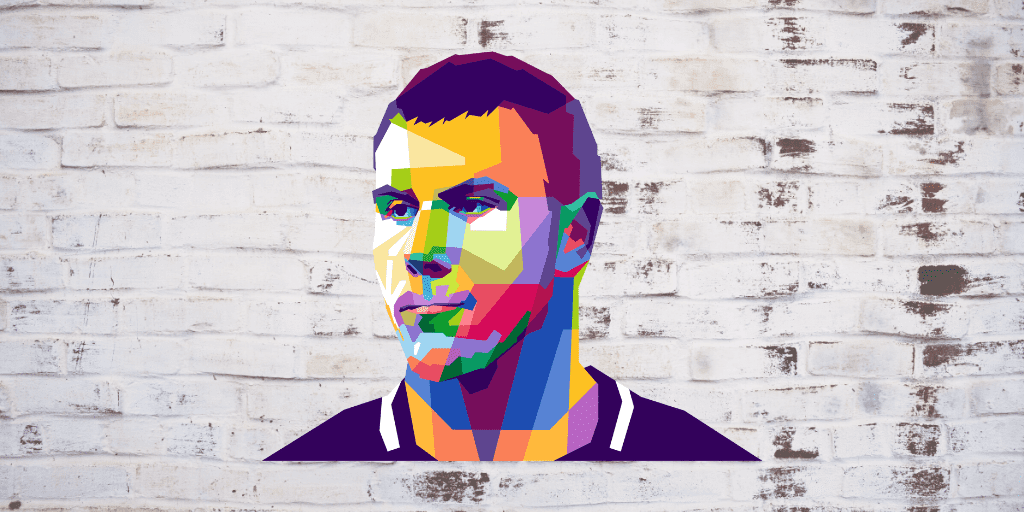


Comments